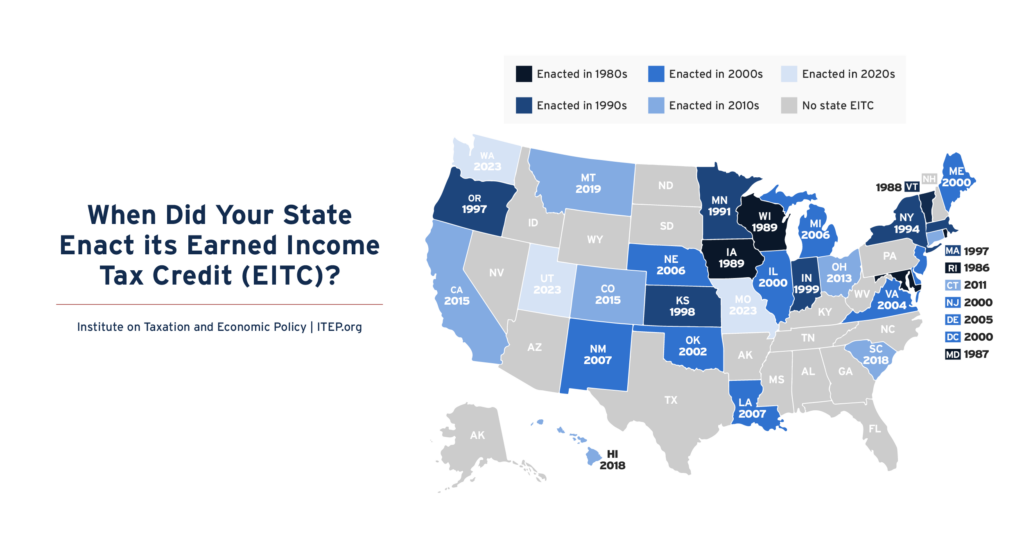Download National and State-by-State Data
The federal Earned Income Tax Credit (EITC) has benefited low- and moderate-income workers for nearly a half century. The credit is one of the nation’s most significant and effective anti-poverty programs, helping workers meet their basic needs in the short run while also bolstering their long-run economic security.
Yet, throughout its history, the EITC has left too many people behind. Workers without children in the home—a group that includes noncustodial parents whose children live most of the year with another parent—receive little benefit from the existing federal EITC. Their maximum credit is substantially smaller than for those with children, and the income levels at which they are eligible are set much lower. Workers without children who are younger than 25 or older than 64 receive no benefit from the federal EITC. It excludes young childless workers just getting a foothold in the job market and older adults working well beyond the traditional retirement age.
More than one in three young adults would benefit from this change. The bulk of the beneficiaries (57 percent, or nearly 2.9 million people) would be white, as white individuals make up the majority of the U.S. population. But the benefits of this change would reach a diverse group of young adults. Nearly a million young Hispanic individuals would benefit, for example, and would receive an overall boost in their income of $765 million in 2022. Similarly, almost 600,000 young Black people would benefit and would see their incomes lifted by more than $470 million in 2022. This policy change would bolster young adults’ economic security. This policy would be a helpful component of a larger strategy to promote economic mobility and prosperity among people from historically marginalized communities and among young people more broadly.
The American Rescue Plan (ARP) of 2021 temporarily remedied these flaws by[1] expanding the value of the credit for low-income people without dependents and allowing workers 19 through 24, and over age 64, to claim the EITC for the first time. Although these enhancements expired at the end of calendar year 2021, the Build Back Better Act that passed the House last year would reinstate, and make permanent, the following reforms:
- Eliminate a restriction that prevented younger workers without dependent children living in the home from accessing the EITC if they are below age 25 (this cutoff was reduced to age 19)
- Eliminate a restriction that prevented older workers without dependent children from accessing the EITC if they are above age 64
- Boost the size of the EITC for all workers without dependent children to make it more comparable to larger credits already received by workers with children (increasing the maximum 2022 credit from $560 to just over $1,500)
- Increase the income cap for working adults without children in the home, allowing more low-paid childless workers to qualify
Young workers without children in the home would receive a combined boost of nearly $4 billion in EITC benefits in 2022 under these reforms. More than one in three young adults—or more than 5 million people—would regain access to the EITC, with an average benefit of $820. That’s 37 percent of the childless young adult population (aged 19-24) who would see a meaningful income boost in 2022 if policymakers extend the EITC enhancements.
In some ways, the federal EITC enhancements under consideration are playing catch-up with progress at the state level, particularly for young adults. Seven states, for example, have permanently lowered the minimum eligibility age for claiming their state EITCs. California, Maine, Maryland, New Mexico, and New Jersey include 18- to 24-year-old workers without children in the home. Colorado recently included 19- to 24-year-old workers and Minnesota extends its credit to those 21 to 24 years of age.
The following tables use ITEP’s microsimulation tax model to demonstrate how many young adults aged 19-24 would benefit from making permanent the federal ARP enhancements in each state. In this analysis, we assume that the expanded EITC will compel more young adults to file on their own (versus as dependents). Access to the EITC is particularly important[2] for this population given that young adults face the highest poverty rates of any age group in the U.S. This legislation presents an opportunity to reinstate the EITC for a population who would benefit greatly from the additional economic security it provides. This analysis is also useful to help identify the potential number of young adult workers who would benefit from a one-year expansion when they file their 2021 taxes this tax filing season.
The benefits for this age group are presented by state, by race and ethnicity, and by average and total amount of EITC received.
[1] The “Childless” EITC: Temporary Expansion for 2021 Under the American Rescue Plan Act of 2021 (ARPA; P.L. 117-2), Congressional Research Service, May 3, 2021. https://crsreports.congress.gov/product/pdf/IN/IN11610
[2] Coffey, Amelia, et al. Young People and Tax Credits: The Earned Income Tax Credit and the Child Tax Credit, Urban Institute, February 2021. https://www.urban.org/sites/default/files/publication/103587/young-people-and-tax-credits_0.pdf




